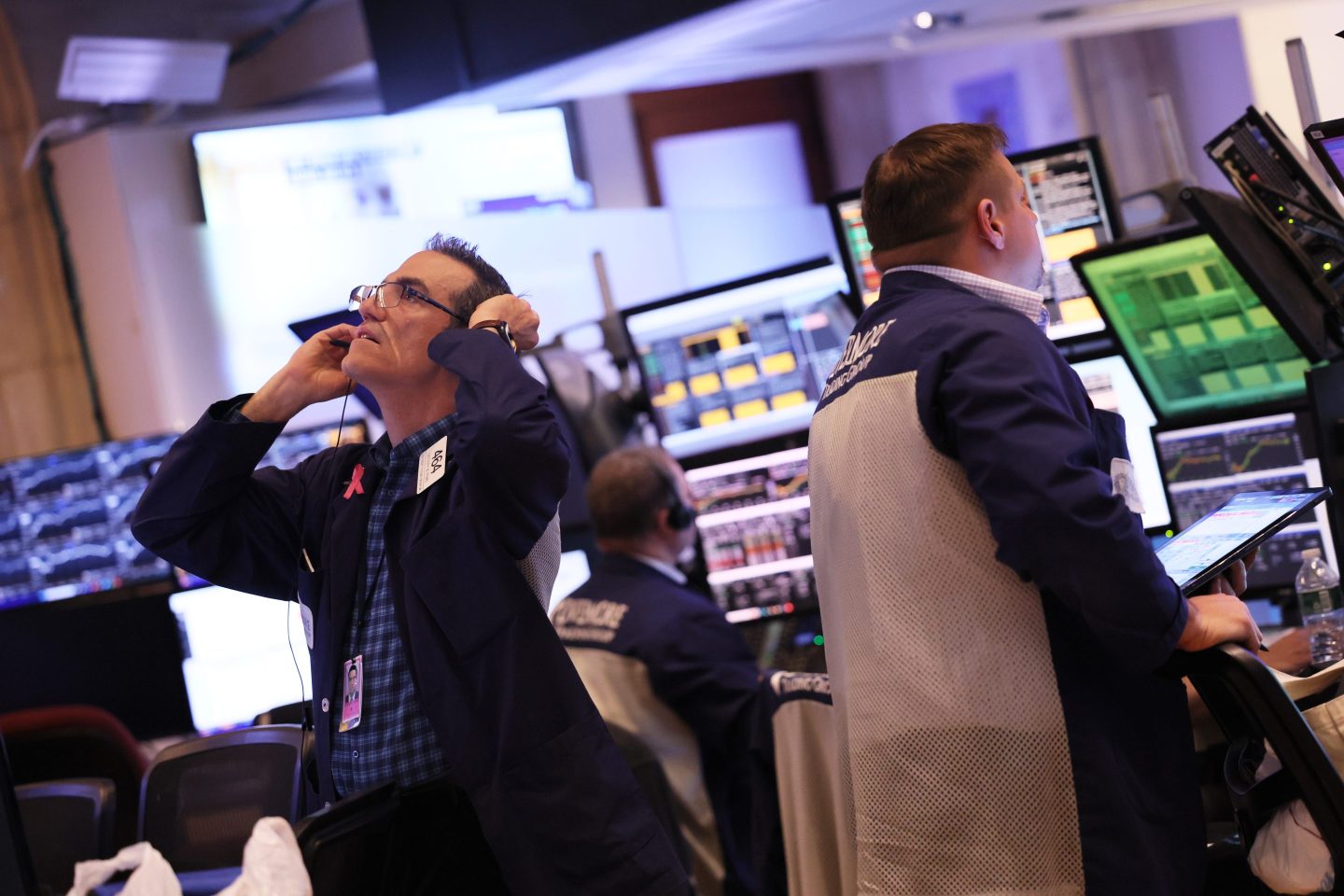
去年7月,邁克爾·加彭成為美國(guó)銀行(Bank of America)首席經(jīng)濟(jì)學(xué)家。不久之后,他警告美國(guó)經(jīng)濟(jì)將在年底出現(xiàn)“輕度衰退”。加彭的前任們一直避免發(fā)布過(guò)度悲觀的預(yù)測(cè),但他擔(dān)心,在持續(xù)通脹和加息的大環(huán)境下,美國(guó)經(jīng)濟(jì)可能出現(xiàn)最糟糕的狀況。然而,去年9月,由于美國(guó)消費(fèi)者支出和勞動(dòng)力市場(chǎng)的表現(xiàn)超出他的預(yù)期,因此這位前巴克萊(Barclays)高管修改了自己的初始預(yù)測(cè),他認(rèn)為在今年上半年之前不會(huì)發(fā)生輕度衰退。
現(xiàn)在,與許多同行一樣,事實(shí)證明加彭的預(yù)測(cè)至少有一點(diǎn)草率。盡管美國(guó)面臨惡性通脹,億萬(wàn)富翁投資者們也紛紛給出末日預(yù)測(cè),但美國(guó)經(jīng)濟(jì)繼續(xù)好轉(zhuǎn),失業(yè)率始終維持在接近疫情之前的最低水平,零售銷售也極具韌性。股市經(jīng)歷過(guò)2022年的低迷之后也開(kāi)始反彈。隨著人工智能重塑全球經(jīng)濟(jì)的潛力引起投資者的投資熱情,標(biāo)普500指數(shù)從年初至今已經(jīng)上漲了超過(guò)15%。
諸多好消息使加彭本周再次修改了對(duì)經(jīng)濟(jì)衰退的預(yù)測(cè)。現(xiàn)在他表示,美國(guó)經(jīng)濟(jì)會(huì)到2024年出現(xiàn)“更溫和的”下滑。
他在周三的客戶報(bào)告中寫(xiě)道:“考慮到好轉(zhuǎn)的風(fēng)險(xiǎn)狀況和其他證明經(jīng)濟(jì)韌性的證據(jù),我們調(diào)整了預(yù)期經(jīng)濟(jì)下滑的時(shí)機(jī)。我們承認(rèn)這并非我們第一次修改預(yù)測(cè)。”
加彭表示,他希望避免“預(yù)測(cè)未來(lái)六個(gè)月的長(zhǎng)期經(jīng)濟(jì)下滑”,但他還表示,他依舊認(rèn)為如果美聯(lián)儲(chǔ)想要控制通貨膨脹,將不得不加息,直到失業(yè)率大幅升高為止。雖然上個(gè)月的通脹率從2022年6月最高的9.1%同比下降至4%,但依舊遠(yuǎn)高于美聯(lián)儲(chǔ)2%的目標(biāo)通脹率。
加彭寫(xiě)道:“盡管如此,考慮到勞動(dòng)力供應(yīng)狀況的好轉(zhuǎn),以及在沒(méi)有失業(yè)率支持的情況下已經(jīng)發(fā)生了通貨緊縮的證據(jù),我們降低了經(jīng)濟(jì)衰退的嚴(yán)重程度。我們現(xiàn)在預(yù)測(cè),發(fā)生‘增長(zhǎng)型衰退’和‘輕度衰退’的可能性相當(dāng)。”
增長(zhǎng)型衰退是指經(jīng)濟(jì)維持低速正向增長(zhǎng),但失業(yè)率上升,而單純的經(jīng)濟(jì)衰退則是大范圍的持續(xù)經(jīng)濟(jì)收縮,通常被定義為連續(xù)兩個(gè)季度GDP負(fù)增長(zhǎng)。
加彭表示,他之所以本周更新對(duì)經(jīng)濟(jì)衰退的預(yù)測(cè),部分原因是移民增加和勞動(dòng)力參與率提高所導(dǎo)致的“勞動(dòng)力供應(yīng)的快速反彈”。他表示,這種反彈幫助失業(yè)率維持在較低水平,并抑制了工資增長(zhǎng),使通貨膨脹從2022年6月的四十年最高有所下降,但沒(méi)有引發(fā)經(jīng)濟(jì)衰退。
加彭表示,最近幾個(gè)月,美國(guó)經(jīng)濟(jì)增長(zhǎng)面臨的諸多風(fēng)險(xiǎn)開(kāi)始消失。他提到了債務(wù)上限獲得通過(guò),以及三月硅谷銀行(Silicon Valley Bank)倒閉后美聯(lián)儲(chǔ)采取的在區(qū)域銀行“控制壓力”的措施等。
他寫(xiě)道:“我們沒(méi)有預(yù)測(cè)到債務(wù)上限危機(jī)的負(fù)面影響,但債務(wù)上限獲得通過(guò)減少了不確定性。”此外,雖然現(xiàn)在宣布銀行貸款的信用恐慌風(fēng)險(xiǎn)‘已全部解除’為時(shí)尚早,但區(qū)域銀行業(yè)的壓力并未變得更嚴(yán)重,而且到目前為止避免了危機(jī)蔓延。”
加彭還指出,拜登政府“旨在刺激制造業(yè)投資”的《芯片法案》(CHIPS)、《通脹削減法案》(Inflation Reduction Act)和《基礎(chǔ)設(shè)施投資和就業(yè)法案》等,幫助促進(jìn)了經(jīng)濟(jì)增長(zhǎng)。
他表示,他現(xiàn)在預(yù)測(cè)今年第四季度,美國(guó)的GDP將增長(zhǎng)1.1%,相比之下他在去年9月預(yù)測(cè)GDP將下降0.2%。但這位經(jīng)濟(jì)學(xué)家將對(duì)美國(guó)2024年GDP增長(zhǎng)率的預(yù)測(cè)從0.9%下調(diào)至0%,因?yàn)樗J(rèn)為明年大部分時(shí)間,美國(guó)經(jīng)濟(jì)需要從上半年的增長(zhǎng)型衰退后開(kāi)始恢復(fù)。
美國(guó)銀行并非唯一一家近期看好美國(guó)經(jīng)濟(jì)的投行。高盛(Goldman Sachs)經(jīng)濟(jì)學(xué)家本月早些時(shí)候也修改了其經(jīng)濟(jì)衰退預(yù)測(cè),將美國(guó)今年發(fā)生經(jīng)濟(jì)衰退的概率從3月預(yù)測(cè)的35%下調(diào)至25%。Stifel也調(diào)整了預(yù)測(cè),其分析師稱在短期內(nèi)美國(guó)不會(huì)發(fā)生“教科書(shū)式的經(jīng)濟(jì)衰退”。(財(cái)富中文網(wǎng))
翻譯:劉進(jìn)龍
審校:汪皓
去年7月,邁克爾·加彭成為美國(guó)銀行(Bank of America)首席經(jīng)濟(jì)學(xué)家。不久之后,他警告美國(guó)經(jīng)濟(jì)將在年底出現(xiàn)“輕度衰退”。加彭的前任們一直避免發(fā)布過(guò)度悲觀的預(yù)測(cè),但他擔(dān)心,在持續(xù)通脹和加息的大環(huán)境下,美國(guó)經(jīng)濟(jì)可能出現(xiàn)最糟糕的狀況。然而,去年9月,由于美國(guó)消費(fèi)者支出和勞動(dòng)力市場(chǎng)的表現(xiàn)超出他的預(yù)期,因此這位前巴克萊(Barclays)高管修改了自己的初始預(yù)測(cè),他認(rèn)為在今年上半年之前不會(huì)發(fā)生輕度衰退。
現(xiàn)在,與許多同行一樣,事實(shí)證明加彭的預(yù)測(cè)至少有一點(diǎn)草率。盡管美國(guó)面臨惡性通脹,億萬(wàn)富翁投資者們也紛紛給出末日預(yù)測(cè),但美國(guó)經(jīng)濟(jì)繼續(xù)好轉(zhuǎn),失業(yè)率始終維持在接近疫情之前的最低水平,零售銷售也極具韌性。股市經(jīng)歷過(guò)2022年的低迷之后也開(kāi)始反彈。隨著人工智能重塑全球經(jīng)濟(jì)的潛力引起投資者的投資熱情,標(biāo)普500指數(shù)從年初至今已經(jīng)上漲了超過(guò)15%。
諸多好消息使加彭本周再次修改了對(duì)經(jīng)濟(jì)衰退的預(yù)測(cè)。現(xiàn)在他表示,美國(guó)經(jīng)濟(jì)會(huì)到2024年出現(xiàn)“更溫和的”下滑。
他在周三的客戶報(bào)告中寫(xiě)道:“考慮到好轉(zhuǎn)的風(fēng)險(xiǎn)狀況和其他證明經(jīng)濟(jì)韌性的證據(jù),我們調(diào)整了預(yù)期經(jīng)濟(jì)下滑的時(shí)機(jī)。我們承認(rèn)這并非我們第一次修改預(yù)測(cè)。”
加彭表示,他希望避免“預(yù)測(cè)未來(lái)六個(gè)月的長(zhǎng)期經(jīng)濟(jì)下滑”,但他還表示,他依舊認(rèn)為如果美聯(lián)儲(chǔ)想要控制通貨膨脹,將不得不加息,直到失業(yè)率大幅升高為止。雖然上個(gè)月的通脹率從2022年6月最高的9.1%同比下降至4%,但依舊遠(yuǎn)高于美聯(lián)儲(chǔ)2%的目標(biāo)通脹率。
加彭寫(xiě)道:“盡管如此,考慮到勞動(dòng)力供應(yīng)狀況的好轉(zhuǎn),以及在沒(méi)有失業(yè)率支持的情況下已經(jīng)發(fā)生了通貨緊縮的證據(jù),我們降低了經(jīng)濟(jì)衰退的嚴(yán)重程度。我們現(xiàn)在預(yù)測(cè),發(fā)生‘增長(zhǎng)型衰退’和‘輕度衰退’的可能性相當(dāng)。”
增長(zhǎng)型衰退是指經(jīng)濟(jì)維持低速正向增長(zhǎng),但失業(yè)率上升,而單純的經(jīng)濟(jì)衰退則是大范圍的持續(xù)經(jīng)濟(jì)收縮,通常被定義為連續(xù)兩個(gè)季度GDP負(fù)增長(zhǎng)。
加彭表示,他之所以本周更新對(duì)經(jīng)濟(jì)衰退的預(yù)測(cè),部分原因是移民增加和勞動(dòng)力參與率提高所導(dǎo)致的“勞動(dòng)力供應(yīng)的快速反彈”。他表示,這種反彈幫助失業(yè)率維持在較低水平,并抑制了工資增長(zhǎng),使通貨膨脹從2022年6月的四十年最高有所下降,但沒(méi)有引發(fā)經(jīng)濟(jì)衰退。
加彭表示,最近幾個(gè)月,美國(guó)經(jīng)濟(jì)增長(zhǎng)面臨的諸多風(fēng)險(xiǎn)開(kāi)始消失。他提到了債務(wù)上限獲得通過(guò),以及三月硅谷銀行(Silicon Valley Bank)倒閉后美聯(lián)儲(chǔ)采取的在區(qū)域銀行“控制壓力”的措施等。
他寫(xiě)道:“我們沒(méi)有預(yù)測(cè)到債務(wù)上限危機(jī)的負(fù)面影響,但債務(wù)上限獲得通過(guò)減少了不確定性。”此外,雖然現(xiàn)在宣布銀行貸款的信用恐慌風(fēng)險(xiǎn)‘已全部解除’為時(shí)尚早,但區(qū)域銀行業(yè)的壓力并未變得更嚴(yán)重,而且到目前為止避免了危機(jī)蔓延。”
加彭還指出,拜登政府“旨在刺激制造業(yè)投資”的《芯片法案》(CHIPS)、《通脹削減法案》(Inflation Reduction Act)和《基礎(chǔ)設(shè)施投資和就業(yè)法案》等,幫助促進(jìn)了經(jīng)濟(jì)增長(zhǎng)。
他表示,他現(xiàn)在預(yù)測(cè)今年第四季度,美國(guó)的GDP將增長(zhǎng)1.1%,相比之下他在去年9月預(yù)測(cè)GDP將下降0.2%。但這位經(jīng)濟(jì)學(xué)家將對(duì)美國(guó)2024年GDP增長(zhǎng)率的預(yù)測(cè)從0.9%下調(diào)至0%,因?yàn)樗J(rèn)為明年大部分時(shí)間,美國(guó)經(jīng)濟(jì)需要從上半年的增長(zhǎng)型衰退后開(kāi)始恢復(fù)。
美國(guó)銀行并非唯一一家近期看好美國(guó)經(jīng)濟(jì)的投行。高盛(Goldman Sachs)經(jīng)濟(jì)學(xué)家本月早些時(shí)候也修改了其經(jīng)濟(jì)衰退預(yù)測(cè),將美國(guó)今年發(fā)生經(jīng)濟(jì)衰退的概率從3月預(yù)測(cè)的35%下調(diào)至25%。Stifel也調(diào)整了預(yù)測(cè),其分析師稱在短期內(nèi)美國(guó)不會(huì)發(fā)生“教科書(shū)式的經(jīng)濟(jì)衰退”。(財(cái)富中文網(wǎng))
翻譯:劉進(jìn)龍
審校:汪皓
After taking over the chief economist gig at Bank of America last July, Michael Gapen quickly warned that the U.S. economy was headed for a “mild recession” by year’s end. Gapen’s predecessors had long avoided overly bearish predictions, but he feared the worst amid persistent inflation and rising interest rates. However, the former Barclays exec revised his initial forecast in September after consumer spending and the labor market “held up” better than he’d expected, arguing that a mild recession wouldn’t come until the first half of this year.
And now, as with many of his peers, Gapen’s forecasts have proven to be, at the least, a bit premature. Despite stubborn inflation and doomsday predictions from billionaire investors, the U.S. economy continues to push forward, with the unemployment rate sticking near pre-pandemic lows and retail sales proving to be resilient. The stock market has also rebounded after a dismal 2022. The S&P 500 is now up more than 15% year to date amid investors’ increasing enthusiasm over the potential for A.I. to reshape the global economy.
The good news forced Gapen to revise his recession forecast once again this week. He now says there’s going to be a “softer” downturn, and it won’t come until 2024.
“We have taken on board the improved risk backdrop and further evidence of resilience and moved out the timing of our anticipated downturn,” the economist wrote in a Wednesday note to clients. “We acknowledge that this is not the first time we have done so.”
Gapen said he wants to avoid “forecasting a perpetual downturn six months into the future,” but added that he still believes the Federal Reserve will be forced to raise interest rates until there is a significant increase in unemployment if it wants to tame inflation. Although year-over-year inflation slowed from its June 2022 high of 9.1% to 4% last month, it remains well above the central bank’s 2% target rate.
“That said, we have softened the magnitude of the downturn given the improved picture on labor supply and evidence that some disinflation has occurred without any real backup in the unemployment rate,” Gapen wrote. “Our forecast is now as much a ‘growth recession’ as it is a ‘mild recession.’”
A growth recession involves a period of low but positive economic growth and rising unemployment, whereas a pure recession is a period of widespread and sustained economic contraction, usually defined as two quarters of negative GDP growth.
Gapen said he updated his recession forecast this week due in part to a “rapid rebound in labor supply” caused by increased immigration and improved workforce participation rates. This rebound has helped the unemployment rate to remain low and held down wage growth, enabling inflation to fall from its June 2022 four decade high without sparking a recession, he said.
Risks to U.S. economic growth have also begun to fade in recent months, according to the economist, who pointed to examples like the passage of the debt ceiling and the Fed’s actions to “contain stresses” at regional banks after the blowup of Silicon Valley Bank in March.
“We did not expect adverse fireworks from a debt limit debacle, but nonetheless, its passing reduces uncertainty,” he wrote. “In addition, while it is too early to declare ‘a(chǎn)ll clear’ on risks of a credit crunch in bank lending, stresses in the regional banking sector do not appear to be getting worse, and spillovers have so far been avoided.”
Gapen also noted that the Biden Administration’s CHIPS and Inflation Reduction Act (IRA), and Infrastructure Investment and Jobs Act (IIJA), which are “aimed at spurring investment in the manufacturing sector,” have helped boost economic growth.
He said he now expects U.S. GDP to rise 1.1% in the fourth quarter of this year, compared to his September prediction for a 0.2% drop. But the economist lowered his forecast for 2024 GDP growth from 0.9% to 0%, arguing that the economy will spend much of next year recovering from its first-half growth recession.
Bank of America isn’t the only investment bank to turn bullish on the economy recently. Goldman Sachs economists revised their recession forecast earlier this month as well, arguing there is now just a 25% chance of a U.S. recession this year, down from 35% in March. And Stifel followed suit, with analysts claiming there won’t be a “textbook recession” anytime soon.






